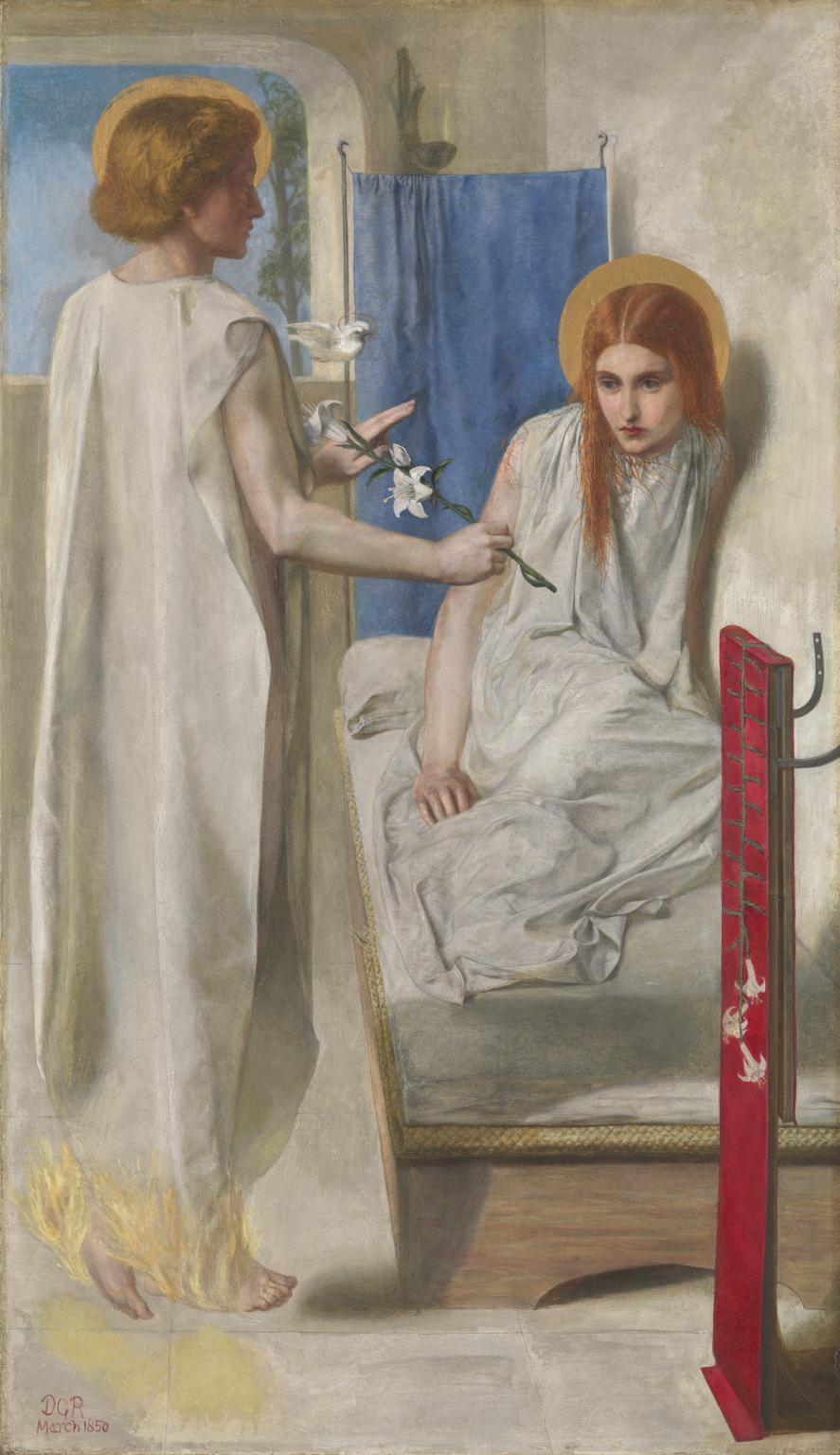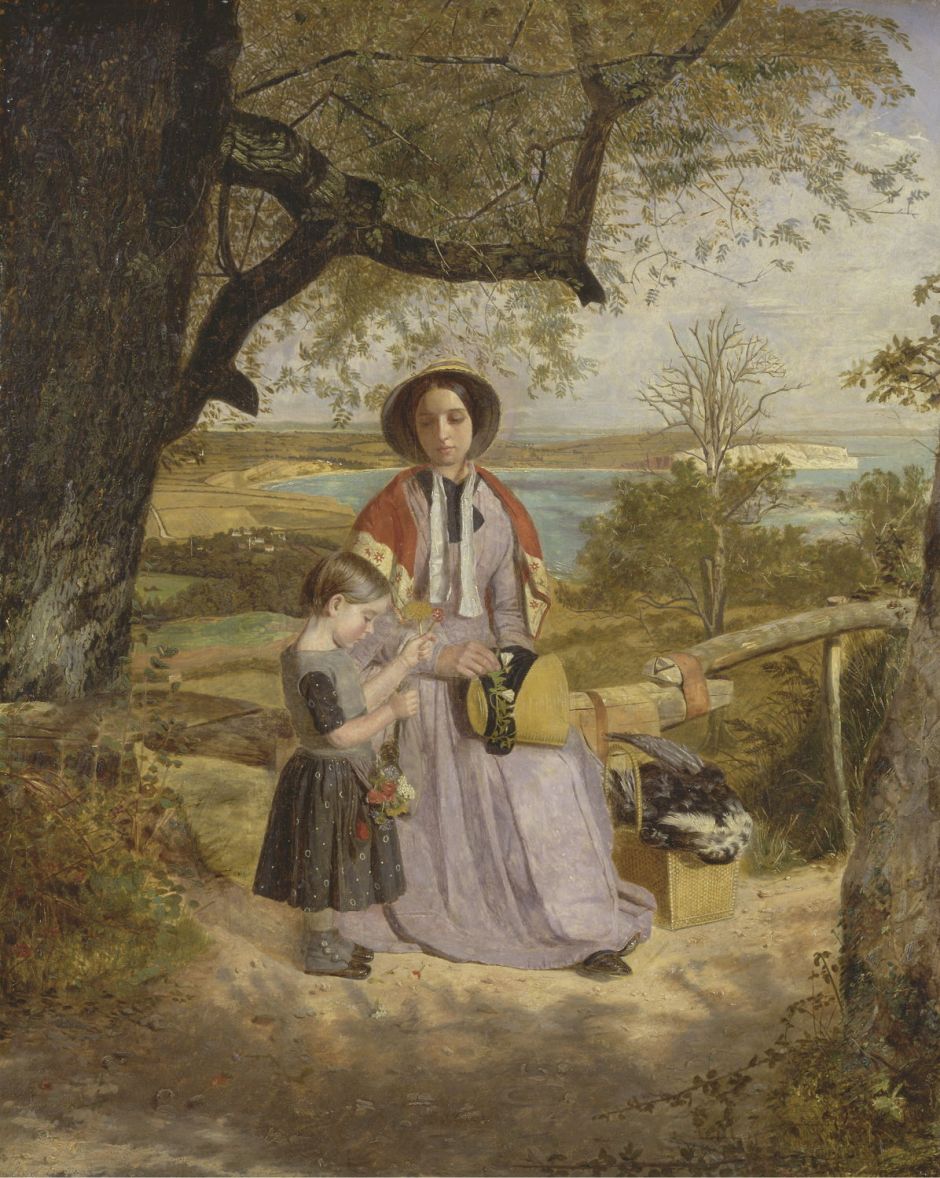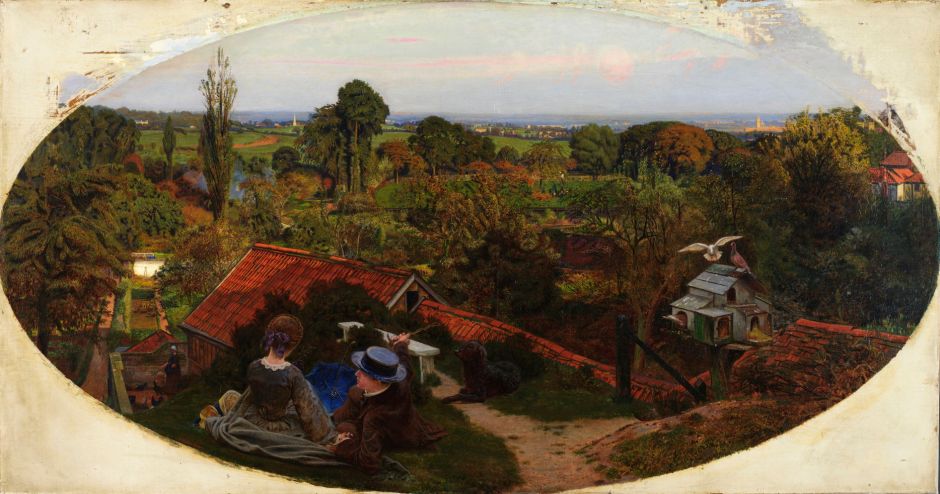Yesterday I showed examples of paintings which developed Raphael’s legacy. In the middle of the nineteenth century, a small group of young artists decided that they wanted to return to what they argued was a ‘purer’ painting before Raphael.
The Pre-Raphaelite Brotherhood (PRB) was formed as a close-knit and often co-habiting artistic group in 1848, in England. Its early doctrines were expressed in four declarations:
- to have genuine ideas to express,
- to study nature attentively, so as to know how to express them,
- to sympathise with what is direct and serious and heartfelt in previous art, to the exclusion of what is conventional and self-parodying and learned by rote,
- most indispensable of all, to produce thoroughly good pictures and statues.
Their intention was to reform art by rejection of what they considered the mechanistic approach to painting which had come to dominate from Raphael onwards, and was epitomised by the work and influence of Sir Joshua Reynolds. They preferred the intense colours, detail, and complex compositions of Italian ‘quattrocento’ art (of the 1400s). The movement went into decline after 1860, but individuals kept its ideals and style alive well into the twentieth century.
Painters who were members of the PRB itself were:
- James Collinson (1825-1881)
- William Holman Hunt (1827-1910)
- John Everett Millais (1829-1896)
- Dante Gabriel Rossetti (1828-1882)
Although their paintings were generally pilloried by critics, one young critic, John Ruskin (1819-1900) took up their cause to the point where he effectively became their leader and directed their painting. He put their case in his 1853 book Pre-Raphaelitism thus:
“The doom of the arts of Europe went forth from that chamber [Raphael’s Stanza della Segnatura], and it was brought about in great part by the very excellencies of the man who had thus marked the commencement of decline. The perfection of execution and the beauty of feature which were attained in his works, and in those of his great contemporaries, rendered finish of execution and beauty of form the chief objects of all artists; and thenceforward execution was looked for rather than thought, and beauty rather than veracity.
And as I told you, these are the two secondary causes of the decline of art; the first being the loss of moral purpose. Pray note them clearly. In mediæval art, thought is the first thing, execution the second; in modern art execution is the first thing, and thought the second. And again, in mediæval art, truth is first, beauty second; in modern art, beauty is first, truth second. The mediæval principles led up to Raphael, and the modern principles lead down from him.”

John Everett Millais’ Isabella (Lorenzo and Isabella) from 1848-49 is one of the first Pre-Raphaelite masterpieces. It tells a fictional story taken from John Keats’ posthumously published retelling of a story in Boccaccio’s Decameron. Although faithful to Keats’ poem, as a work of fiction veracity isn’t particularly meaningful, as all the figures are models, and the setting imaginary.

Millais’ Christ in the House of His Parents (also known as The Carpenter’s Shop) (1849–50) was shown at the Royal Academy in 1850 without a title, but with this quotation from the Old Testament book of Zechariah 13:6: “And one shall say unto him, What are those wounds in thine hands? Then he shall answer, Those with which I was wounded in the house of my friends.” It too shows a fictional scene, which isn’t even alluded to in the Gospels, in which the young Jesus Christ is being comforted by his kneeling mother, after he has cut the palm of his left hand on a nail.
The figures and objects are depicted with great and meticulous realism, and were painted from nature. Nevertheless the composition abounds with symbols of Christ’s life and future crucifixion: the cut on his palm is one of the stigmata, and blood dripped from that onto his left foot is another. The young Saint John the Baptist has fetched a bowl of water, indicating his future baptismal role. A triangle above Christ’s head symbolises the Trinity, and a white dove perched on the ladder is the Holy Spirit. A flock of sheep outside represents the Christian flock.

Dante Gabriel Rossetti’s painting of The Girlhood of Mary Virgin (1848–9) not only depicts an imaginary scene, but one which contains overt anachronisms. The young Mary is embroidering with her mother, Saint Anne, while her father, Saint Joachim, prunes a vine – by Rossetti’s time, a socially acceptable activity for a gentleman. Rosetti uses Mary’s embroidery to introduce the symbolic colour red, signifying the Passion to come, and this slow, painstaking activity as a symbol of the demands of motherhood.

Rossetti departs from convention throughout this painting of the Annunciation, using a title from the Vulgate text of Ecce Ancilla Domini! (1849–50). It combines great naturalism in its figures with deeply traditional plate-like gilt halos, and features a rich language of symbols including white robes for purity, red embroidery for Christ’s crucifixion, a blue curtain for heaven, and flames at the feet of Gabriel rather than angel’s wings.

James Collinson, one of the less well-known members of the PRB, painted his Mother and Child by a Stile, with Culver Cliff, Isle of Wight, in the Distance in about 1850. Having visited the site where he painted this, it appears neither more nor less faithful to nature than other landscape paintings of the time.

One of the best-known Pre-Raphaelite paintings is Millais’ Ophelia, which he painted between 1851-2. This shows the climax of another fictional story, taken from Shakespeare’s tragedy Hamlet, in which Ophelia drowns herself in the “weeping brook”. Its background was painted en plein air near Ewell, Surrey, England, during 1851. The figure of Ophelia was painted in over the following winter, using as the model Lizzie Siddal in a bathtub full of water.
Millais used extensive symbolism in the flowers shown: roses for love, and possibly alluding to her brother calling her the ‘rose of May’; willow, nettle and daisy for forsaken love, suffering, and innocence, respectively; pansies for love in vain; violets (in her necklace chain) for faithfulness, chastity, or young death; poppies for death; forget-me-nots for remembrance. Each was painted in the studio from life, and superimposed on the background to form a composite image which never existed in reaality.

William Holman Hunt’s The Awakening Conscience is an open-ended narrative which he painted in the period 1851-53. Its fictional story has to be assembled from a multitude of clues which are to be found in its image.
It shows a fashionable young man seated at a piano in a small if not cramped house in the leafy suburbs of London, in reality Saint John’s Wood. Half-risen from the man’s lap is a young woman who stares absently into the distance. They’re clearly a couple in an intimate relationship, but conspicuous by its absence is any wedding ring on the fourth finger of the woman’s left hand, which is at the focal point of the painting. This is, therefore, extra-marital.
Around them are signs that she is a kept mistress with time on her hands. Her companion, a cat, is under the table, where it has caught a bird with a broken wing, a symbol of her plight. At the right edge is a tapestry with which to while away the hours, and her wools below form a tangled web in which she is entwined. On top of the gaudy upright piano is a clock. By the hem of her dress is her lover’s discarded glove, symbolising her ultimate fate when he discards her into prostitution. The room itself is decorated as gaudily as the piano, and in poor taste.
The couple have been singing together from Thomas Moore’s Oft in the Stilly Night when she appears to have undergone some revelatory experience, causing her to rise. For Hunt this is associated with a verse from the Old Testament book of Proverbs: “As he that taketh away a garment in cold weather, so is he that singeth songs to an heavy heart.” Ironically, his model was his girlfriend at the time, Annie Miller, an uneducated barmaid who was only sixteen herself.
Hunt leads us to imagine that this kept mistress has had a religious moment, seeing the route to her redemption as her conscience is awakened. The image brings hope without any resolution.

Hunt’s celebrated landscape Our English Coasts, from 1852, might appear to be a natural stretch of coastline on the cliffs overlooking Covehurst Bay, near Hastings, on the south coast of England. It is in fact a carefully assembled composite of several different views of the same location, and the butterlies in the left foreground were added later, being painted in the studio from live specimens.

Ford Madox Brown’s intricate view over the suburbs of London in An English Autumn Afternoon, 1852-1853 was painted from his landlady’s bedroom window in Hampstead during the whole month of October in 1852. Even that period proved insufficient, and the artist needed a further two months work to complete the painting in the Spring of 1854, when the view was inevitably quite different in appearance.

Of all the Pre-Raphaelite painters, by far the most faithful to nature was the aspiring landscape specialist John Brett, who in 1858 started to paint this magnificent view of Val d’Aosta in front of the motif. Working in fine detail and painting from life, he followed the principles laid down by Ruskin. This proved so demanding that the artist brought the painting back to England for completion during the late autumn of that year. Ruskin then damned it by writing that “it seems to me to be wholly emotionless. I cannot find from it that the painter loved, or feared, anything in all that wonderful piece of the world.”
These ambitious and idealistic young artists did make many superb paintings. But if they had set out to demonstrate a ‘purer’ art than Raphael’s, they failed to convince, and showed that creating great paintings can seldom be true to nature, relying instead on trickery and artifice.

